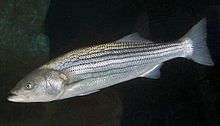Microcotyle eueides
Microcotyle eueides is a species of monogenean, parasitic on the gills of a marine fish. It belongs to the family Microcotylidae.[2]
| Microcotyle eueides | |
|---|---|
| Scientific classification | |
| Kingdom: | Animalia |
| Phylum: | Platyhelminthes |
| Class: | Monogenea |
| Order: | Mazocraeidea |
| Family: | Microcotylidae |
| Genus: | Microcotyle |
| Species: | M. eueides |
| Binomial name | |
| Microcotyle eueides MacCallum & MacCallum, 1913 | |
| Synonyms | |
| |
Systematics
Microcotyle eueides was first described by MacCallum & MacCallum (1913) from the gills of the striped bass Morone saxatilis (Moronidae), designated as Roccus lineatus in the original publication.[2] Unnithan (1971) placed M. eueides in the new genus and subgenus Caenomicrocotyle as Caenomicrocotyle (Caenomicrocotyle) eueides.[1] However, this species was returned to the genus Microcotyle by Mamaev in 1986.[3]
Morphology
Microcotyle eueides has the general morphology of all species of Microcotyle, with a symmetrical very delicate and thin body, narrowed at each end and comprising an anterior part which contains most organs and a posterior part called the haptor. The haptor is symmetrical, and bears clamps, arranged as two rows, one on each side. The clamps of the haptor attach the animal to the gill of the fish. There are also two buccal lateral, imperforate suckers at the anterior extremity. The digestive organs include an anterior, terminal mouth, a small and inconspicuous pharynx, an oesophagus and a posterior intestine with two lateral branches provided with numerous secondary branches; the branches extends far back into the haptor. Each adult contains male and female reproductive organs. The reproductive organs include an anterior genital atrium, armed with numerous spines, a medio-dorsal vagina, a single large ovary coiled across the middle of the body and 32 small testes which are posterior to the ovary. The eggs are elliptical, with a very long and delicate anterior filament that becomes coiled in a dense mass just near the opening of the uterus.[2]
Hosts and localities

The type-host is the striped bass (Morone saxatilis) (Moronidae), designated as Roccus lineatus in the original publication. The type-locality is New York.[2]
References
- Unnithan, R. V. (1971). On the functional morphology of a new fauna of Monogenoidea on fishes from Trivandrum and environs. Part IV. Microcotylidae sensu stricto and its repartition into subsidiary taxa. American Midland Naturalist, 366-398.
- MacCallum, G. A., & MacCallum, W. G. (1913). Four species of Microcotyle, M. pyragraphorus, macroura, eueides and acanthophallus. Zoologische Jahrbücher Abteilung für Systematik, 34, 223-244. https://www.biodiversitylibrary.org/page/9988712#page/233/mode/1up

- Mamaev, Y. L. (1986). The taxonomical composition of the family Microcotylidae Taschenberg, 1879 (Monogenea). Folia Parasitologica, 33, 199-206. PDF
